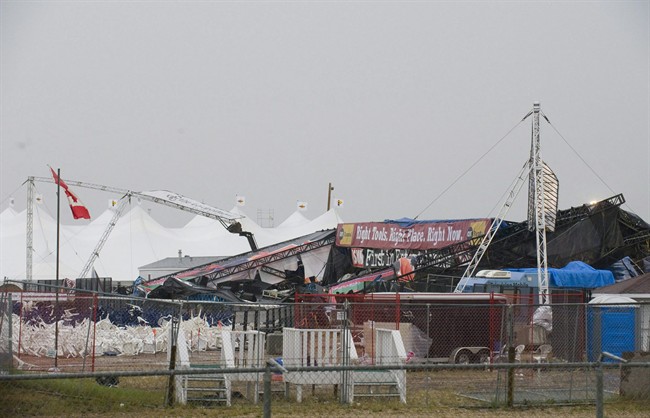EDMONTON – A fatality inquiry into the death of a spectator at an Alberta country music festival is recommending national design standards for temporary stages.

The inquiry report released Monday detailed how Donna Moore was crushed by heavy speakers when high winds caused the stage to collapse at the Big Valley Jamboree in Camrose on Aug. 1, 2009.
The 35-year-old single mother from Lloydminster, Alta., had been randomly chosen with others to sit on special bleachers on the main stage. With news of an approaching storm and winds gusts of 100 kilometres per hour, concert staff had started evacuating the stage. But it was too late.
READ MORE: Big Valley Jamboree fatality inquiry begins
An engineering study showed the stage came down due to worn ratchet straps.
“Since this stage or ones like it appear to be set up and used in various locations across Canada (and elsewhere in North America) and there is a national body, the National Research Council, which recommends building standards reflecting a level of risk acceptable to Canadians, I recommend the National Research Council create a national standard for the design of temporary stages,” wrote provincial court Judge William Andreassen.
“I am concerned that municipalities and event promoters will become or remain complacent about stage design and erection.

Get daily National news
“As memory of this disaster fades, they may again simply defer to experienced stage providers who may again pay insufficient attention to detail in performing what … is a routine assembly project.”
The stage collapse was the first of several around the world that summer.
Six people died when a stage went down at a Sugarland concert in Indianapolis; five died in Belgium when a storm swept in and toppled a stage at the Pukkelpop Festival; and several people were injured when a stage collapsed at Bluesfest in Ottawa.
READ MORE: Bigger outdoor concerts amp up concerns about safety, regulation
The Alberta government laid several charges against three businesses involved with the Big Valley festival — Panhandle Productions, Global Production Co. and a numbered Alberta company, but the charges were stayed in 2012. The Crown said there was no reasonable chance of conviction.
During the inquiry last year, Andreassen heard there was no engineer-approved design for the concert stage. No one had applied for a stage permit, but the City of Camrose didn’t appear to require one.
The report said an organizer had been monitoring the weather that afternoon and, about 20 minutes before the stage collapsed, there was talk of possibly clearing the bleachers.
READ MORE: Charges stayed in fatal stage collapse at Big Valley Jamboree
About 10 minutes before the collapse, police notified a concert producer of a possible tornado about 75 kilometres away and suggested shutting down the concert. Officers made another call a few minutes later after learning winds were getting closer.
Staff had started taking down parts of the stage, performer Billy Currington was motioned to wrap up his set and people on the bleachers were told to leave.
Although Moore’s friend was among those evacuated from the bleachers, Moore lingered behind and was killed moments later, said the report. Many others were injured.
Among a dozen other recommendations, Andreassen said seating should not be permitted on stages within two hours of the predicted arrival of strong winds.
The judge said festival promoters should also hire professional meteorologists to provide routine and updated weather predictions.
Panhandle has retained a professional meteorologist since the collapse, said the report.

Comments